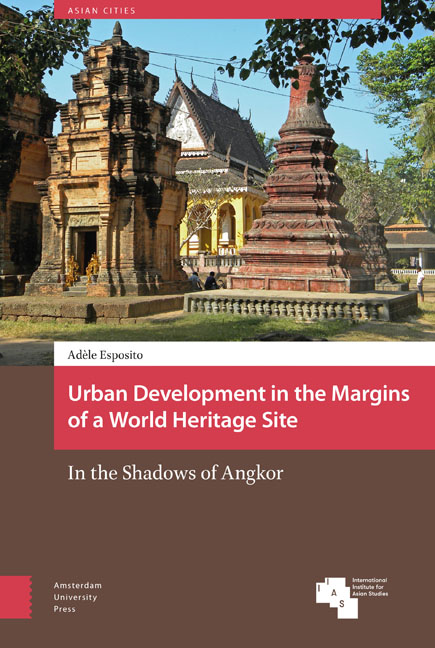Book contents
- Frontmatter
- Dedication
- Contents
- List of Figures
- Abbreviations
- Glossary of Khmer terms
- Acknowledgements
- Author’s Preface
- Introduction
- 1 ‘Before you Build a Wall, Think of What You are Leaving Outside it’: The Construction of Core and Marginal Spaces in the Angkor Region
- 2 The Arena of Urban Planning and the Idea of the City
- 3 The City as Developers’ Playground
- 4 The Architectural Space: How Contemporary Design Shapes Urban Identities and Ideas of Modernity
- Conclusion
- Bibliography
- Index
- Publications / Asian Cities
- Frontmatter
- Dedication
- Contents
- List of Figures
- Abbreviations
- Glossary of Khmer terms
- Acknowledgements
- Author’s Preface
- Introduction
- 1 ‘Before you Build a Wall, Think of What You are Leaving Outside it’: The Construction of Core and Marginal Spaces in the Angkor Region
- 2 The Arena of Urban Planning and the Idea of the City
- 3 The City as Developers’ Playground
- 4 The Architectural Space: How Contemporary Design Shapes Urban Identities and Ideas of Modernity
- Conclusion
- Bibliography
- Index
- Publications / Asian Cities
Summary
The dialectical relation between international heritage recognition and urban development has been at the heart of this book, in which I have explored the ways in which the UNESCO World Heritage label engenders and triggers urbanization on the margins of the Angkor archaeological park. The following pages suggest three research trajectories that have proved useful for Siem Reap-Angkor, and which could be expanded to the analysis of heritage politics in other countries and sites where tourism has become one of the main engines of local and national economies.
Heritage space and non-heritage space: A heuristic model
The territorial system established as a consequence of international heritage recognition is based on the interconnection of two components, namely the heritage space and the non-heritage space. I have analysed this system through the lens of ‘human territoriality’, defined as control over ‘objects, people, and relationships’ within a delimited region called a ‘territory’ (Sack, 1983, p. 56; see Chapter 1). The implementation of territoriality in Siem Reap-Angkor has produced an ambivalent and contradictory process.
Firstly, the bureaucracy of heritage management has become increasingly complex as APSARA departments have increased in number, their relations with national and local authorities have developed, and additional regulations for the archaeological park of Angkor have been established. For instance, tourists now have to comply with a dress code meant to respect the sacred values of Angkor (Plush, 2016). More and more red pillars mark the boundaries of zones 1 and 2, even in remote villages that no one would suspect are protected. Small protective boundaries surround some minor temples in the Siem Reap region, constructing an artificial separation of contemporary pagodas and ancient remains. Approximately, one hundred families formerly living in the precincts of the archaeological park have been relocated to the Run Ta Ek land reserve outside zone 2, with the aim of preventing further construction in the archaeological park. These are among many examples of recent attempts to define acceptable behaviour and to regulate access and occupation of land within the boundaries of the park. They have aimed at reinforcing the territoriality of the archaeological parks and thus the separation of the heritage and non-heritage spaces.
- Type
- Chapter
- Information
- Urban Development in the Margins of a World Heritage SiteIn the Shadows of Angkor, pp. 303 - 310Publisher: Amsterdam University PressPrint publication year: 2018



